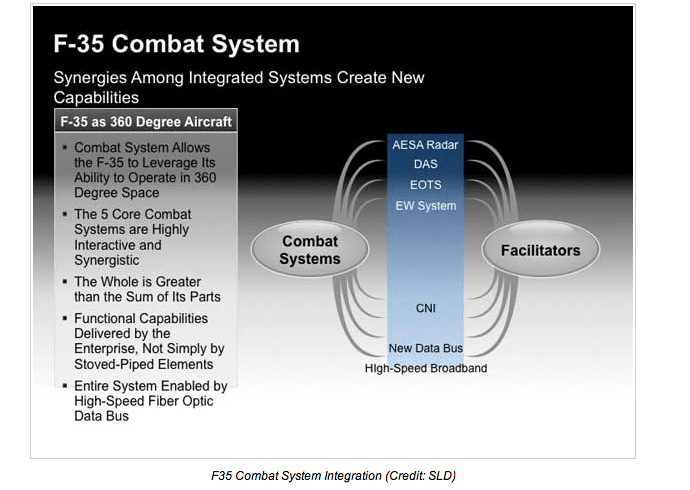A key impact of the F-35 as a fleet will be to enable deployed air power to work simultaneously as a strike and defense force. The F-35 fleet will take multi-mission to a new level. A core enabler for such a role will be the combat system capabilities of the aircraft, which are operational now. Over time, the level of integration of these systems will go up, enabling more capability within the fleet over time.
The F-35 is the first combat aircraft that sees completely around itself, thanks to its Distributed Aperture System, a new sensor concept in air combat. All told, the F-35’s internal sensor suite can see hundreds of miles on a 360-degree basis. And, unlike legacy aircraft, which add systems that need to be managed by the pilot, the F-35’s core combat systems work interactively.
https://www.sldinfo.com/shaping-the-f-35-combat-system-enterprise/
Recently, two of those combat systems demonstrated their the ballistic missile detection, tracking and targeting capabilities. The AN/AAQ-37 distributed aperture system (DAS) and AN/APG-81 active electronically scanned array (AESA) radar aboard the BAC1-11 testbed aircraft autonomously detected, tracked and targeted multiple, simultaneous ballistic rockets. The DAS autonomously detected all five rockets, launched in rapid succession, and tracked them from initial launch well past the second stage burnout.
“Northrop Grumman demonstrated these ballistic missile tracking modes with only minor modifications to the baseline F-35 JSF radar and DAS software,” said Jeff Leavitt, vice president of Northrop Grumman’s combat avionic systems business unit. “Since DAS is always staring simultaneously in every direction, an operator does not have to point the sensor in the direction of a target to gain a track. The F-35 pilot could continue the primary mission while the sensors automatically observe ballistic missile threats.”
And in June 2010 video, the DAS tracked a Space X Falcon 9 (to over 800 miles). This was done inadvertently as the test bed operating in one location picked up a missile launch from another location more than 800 miles away.
Northrop Grumman video showing how its distributed-aperture sensor (DAS) for the F-35 Joint Strike Fighter tracked SpaceX’s Falcon 9 launch vehicle flight during a test flight of the sensor system on the company’s BAC One-Eleven testbed. DAS rpoivies a 360-deg view round the F-35 for missile warning, target tracking and navigation.
The video has been magnified 10 times. DAS detects and tracks the rocket at horizon-break without the aid of external cues, then continuously tracks the rocket through first-stage burnout, second-stage ignition, across boundaries between DAS sensors, and through the rocket’s second-stage burnout at a distance of more than 800 miles. The video also shows the DAS detecting and tracking the rocket’s first-stage re-entry.
Also see,
https://www.sldinfo.com/shaping-redundant-response-u-s-military-space-capabilities/



